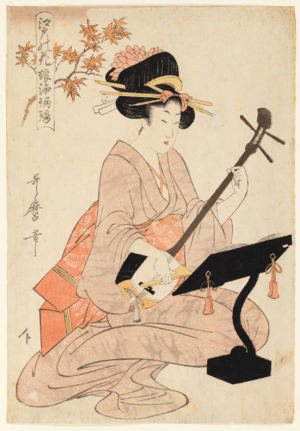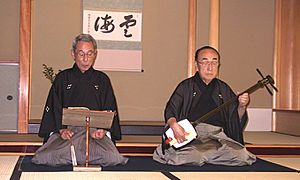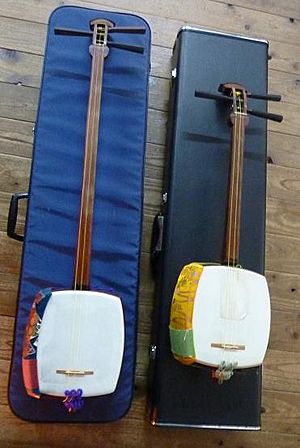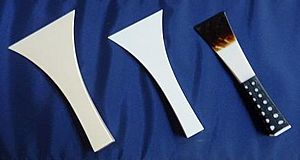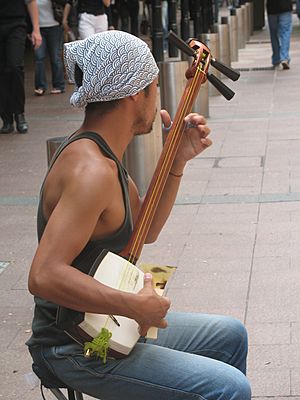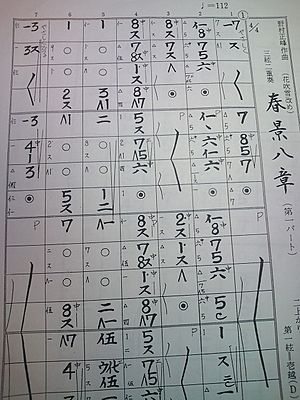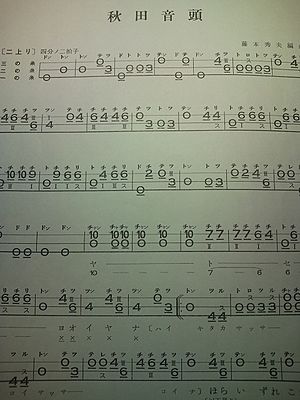Shamisen facts for kids
The shamisen (三味線) is a traditional Japanese musical instrument. It has three strings and is played with a pick called a bachi. Its name means "three strings." The shamisen came from a Chinese instrument called the sanxian.
People usually say "shamisen," but sometimes it's called "jamisen." This happens when it's part of a longer word, like in tsugaru-jamisen. In some parts of Japan, it was also called "samisen."
The shamisen's shape changes depending on the type of music it plays. For example, a shamisen used in kabuki theater has a thin neck. This makes it easier to play fast and fancy music. Shamisen used for puppet plays or folk songs have thicker, longer necks. This helps them make a stronger sound for those types of music.
Contents
How a Shamisen is Made
The shamisen is a string instrument that you pluck. It's built a bit like a guitar or a banjo. It has a neck and strings stretched over a hollow body. The neck of the shamisen is smooth, without frets like a guitar. It's also thinner than a guitar neck.
The body of the instrument is called the dō (胴). It looks like a drum and is covered with skin on both the front and back. This skin helps make the sound louder. In the past, animal skins like dog or cat skin were used. Today, many shamisen use strong plastic materials instead. This is because it's hard to find people who prepare animal skins, and some people prefer not to use them.
The neck, called the sao (棹), usually comes in three or four pieces. These pieces fit together and can be taken apart easily. The neck goes through the drum-like body and holds the strings. The pegs that hold the strings are long and thin. They used to be made of ivory, but now they are often made from wood or plastic.
The three strings of the shamisen are made of silk or nylon. They go from the pegs at the top to a cloth piece at the bottom. A small bridge, called a koma (駒), holds the strings up from the body. The lowest string is set a bit lower to create a special buzzing sound. This sound is called sawari. It's a unique part of the shamisen's sound.
Players often put a cover, called a dō kake, on the body to protect it. They might also wear a small cloth band on their left hand. This helps them slide their hand smoothly along the neck. This band is called a yubikake. The top part of the instrument, the tenjin, can also have a cover.
Silk strings are traditional, but they break easily. So, professional players use them for performances. Students often use nylon or 'tetron' strings. These last longer and cost less.
Different Kinds of Shamisen
Shamisen come in different shapes and sizes. The type of pick (bachi) used also changes with the music style. Shamisen are grouped by their size and the music they play. There are three main sizes: hosozao, chuzao, and futozao.
Traditional Japanese music styles, like jiuta and nagauta, have strict rules for shamisen making. They require specific wood, skin, and picks. However, the tsugaru-jamisen is more modern. It's used in new music styles like jazz and rock. Some tsugaru-jamisen even have electric pickups, like an electric guitar. This lets them connect to amplifiers.
The Smallest Shamisen: Hosozao
The hosozao (細棹, literally "thin neck") is the smallest shamisen. It has a small, square body and a very thin neck. The neck gets even thinner near the body. The hosozao is often used for nagauta music. Its thin neck helps players perform the fast, tricky parts needed for kabuki theater.
The Medium Shamisen: Chuzao
The chuzao (中棹, literally "middle neck") is bigger than the hosozao. Its neck is a bit thicker. Unlike the hosozao, the strings stay the same distance from the neck as it gets closer to the body. This gives the chuzao a higher sound range. It's popular for jiuta-style playing, which has a softer, richer sound. The chuzao is also a good all-around instrument for many music styles.
The Large Shamisen: Futozao
The futozao (太棹, literally "fat neck") shamisen is used for powerful music styles. These include gidayubushi (music for bunraku puppet theater) and tsugaru-jamisen. The thicker neck helps players use more force when playing these styles. The tsugaru-jamisen is a newer type of futozao. It's much larger than older shamisen and has a longer, thicker neck.
The Heike Shamisen
The heike shamisen (平家) is a special shamisen. It's made to play the song Heike Ondo, a folk song from Shimonoseki, Japan. Its neck is about half the length of most shamisen. This gives it the high sound range needed for Heike Ondo. Today, its strings are often made of steel for better sound. The drum heads are made of plastic to prevent breaking during performances.
Different Picks (Bachi)
The bachi (撥) is the pick used to play the shamisen. Picks also come in different sizes, shapes, and materials depending on the music style.
- Nagauta bachi: Can be made of wood, plastic, or ivory. Plastic is an acceptable choice if ivory or wood are too expensive.
- Jiuta bachi: Made from plastic, ivory, or a mix of plastic/ivory with tortoiseshell. These are the longest and widest picks.
- Gidayu bachi: Used for gidayu shamisen, these are the heaviest and thickest picks.
- Tsugaru-jamisen bachi: This is the smallest pick and usually has a tortoiseshell tip.
Other Parts: The Bridge (Koma)
The koma (駒), or bridge, can be made from bamboo, ivory, bone, wood, or plastic. Bridges come in many heights. A higher bridge makes the sound louder. For beginners, lower bridges are usually better.
- Nagauta koma: These bridges are usually made of ivory, bone, or plastic. Ivory gives the best sound but is expensive. Bone (shari) is popular for practice and student performances.
- Jiuta koma: These are often made from yellow or black water buffalo horn. Yellow buffalo horn is the most common.
- Tsugaru koma: These bridges are thin and not very high. The base is often bamboo or wood, and the top part (where the strings go) can be ivory, bone, or tortoiseshell.
How to Play the Shamisen
In most music styles, you pluck the shamisen strings with a bachi. The shamisen's sound is a bit like a banjo. The drum-like body (dō) makes the sound louder. Players often hit both the string and the skin with the pick. This creates a strong, drum-like sound.
For some songs, like kouta (小唄, literally "little song"), players use their fingers instead of a pick. Sometimes, a shamisen can even be played with a violin bow, similar to another Japanese instrument called the kokyū.
Tuning the Shamisen
The shamisen is tuned differently depending on the music style. The names for the notes also change. There are many shamisen styles in Japan, and tunings can be a bit different. Three common tunings are honchoshi (本調子), ni agari (二上がり), and san sagari (三下がり).
Honchoshi Tuning
Honchoshi means "base tuning." It's called this because other tunings come from it. In honchoshi, the first and third strings are tuned an octave apart. The middle string is tuned like a fourth from the first string. For example, the notes could be D, G, D.
Ni Agari Tuning
Ni agari means "raised second." This means the second string's pitch is raised from honchoshi. This makes the gap between the first and second strings a fifth. An example tuning is D, A, D.
San Sagari Tuning
San sagari means "lowered third." For this tuning, you start with honchoshi and lower the third string (the highest one) by a whole step. This makes the instrument tuned in fourths, like D, G, C.
Unlike a guitar or violin, the shamisen doesn't have one set tuning. Players can tune it to fit the singer's voice or their own preference. They just need to follow these tuning patterns.
Shamisen Music Notes
Music for the shamisen can be written using Western music notes. But it's more often written using tablature. Tablature shows you where to place your fingers on the instrument. Even though tunings might be similar, the names for the notes on the neck (called tsubo (壷)) are different for each music style.
For example, in min'yo shamisen style, the open string is "0." But in jiuta shamisen style, notes are grouped by octave, and "1" is the open string. This can make it hard for someone who learns one style to read music from another style.
Tablature can be written in the old Japanese way, from right to left. Or it can be written in a modern way, from left to right, like guitar tablature. Old Japanese tablature uses Chinese characters. Modern tablature often uses Western music terms for how loud or fast to play. The tablature usually tells you which tuning to use.
History of the Shamisen
The Japanese shamisen came from the Chinese sanxian instrument. The sanxian arrived in Japan through the Ryukyu Kingdom (Okinawa) in the 1500s. There, it became the Okinawan sanshin. The shamisen then developed from the sanshin. It's thought that the shamisen's ancestor first came to Japan in the 1500s through the port city of Sakai, near Osaka.
The shamisen can be played alone or with other shamisen. It can also be played with other Japanese instruments or with singing, like in nagauta. It's also used to accompany plays, especially kabuki and bunraku puppet theater. Both men and women have traditionally played the shamisen.
One famous and challenging style is gidayū. It's named after Takemoto Gidayū (1651–1714), who was important in the bunraku puppet theater. The gidayū shamisen and its pick are the largest. The singer-narrator in gidayū speaks all the play's roles and sings about the action. This role is so demanding that performers often switch halfway through a scene.
In the early 1900s, blind musicians like Shirakawa Gunpachirō and Takahashi Chikuzan created a new playing style. It was based on folk songs (min'yō) but included lots of improvisation and fast fingerwork. This style is now called tsugaru-jamisen, named after the region in northern Honshū where it started. It's still popular in Japan. The fast tsugaru-jamisen style is sometimes compared to bluegrass banjo.
kouta (小唄) is a shamisen style mostly played by geisha and maiko. Its name means "little song." Geisha and maiko also learn nagauta, but kouta is what they mostly perform at parties.
Jiuta (地唄, literally "regional song") is a more classical style of shamisen music.
Shamisen in Modern Music
Many modern musicians use the shamisen in new ways.
- Takeharu Kunimoto (1960–2015) played bluegrass music on the shamisen.
- Michihiro Sato plays free improvisation with the instrument.
- Japanese American jazz pianist Glenn Horiuchi used the shamisen in his music.
- The Yoshida Brothers are a popular duo in Japan. They play the shamisen with a fast, energetic style. Their music is influenced by rock guitar.
- Metal guitarist Marty Friedman often uses a shamisen to add an exotic sound to his recordings.
- Takeshi Terauchi & Bunnys used the shamisen with their instrumental rock group.
- Japanese extreme metal band Zenithrash uses shamisen and shakuhachi in their music.
- Japanese rock musician Gackt and his band GacktJOB have performed with shamisen.
- Japanese rock musician Miyavi also plays the shamisen in his albums and concerts.
- The Japanese folk rock/metal band Wagakki Band combines traditional Japanese instruments, including the tsugaru-shamisen, with Western rock.
- Canadian death metal band Quo Vadis used a shamisen in their song "Ego Intuo Et Servo Te."
- American tsugaru-jamisen player Kevin Kmetz leads a rock band called God of Shamisen.
- Japanese traditional and jazz musician Hiromitsu Agatsuma mixes genres. He has arranged jazz songs for the shamisen.
- The pop speed metal band Babymetal also uses the shamisen in their music videos and live shows.
- The French Metal band GaidjinN uses the shamisen in their songs.
- A magical shamisen is a key part of the 2016 movie Kubo and the Two Strings. The main character, Kubo, uses its power to fight enemies.
- Shinobu Kawashima plays shamisen on a cover song by Tokyo Groove Jyoshi.
- Noriko Tadano is a tsugaru shamisen player living in Australia. She has played with many musicians in blues, jazz, and electronic music. She was also in the blues duo 'George & Noriko' on Australia's Got Talent.
Images for kids
See also
 In Spanish: Shamisen para niños
In Spanish: Shamisen para niños



